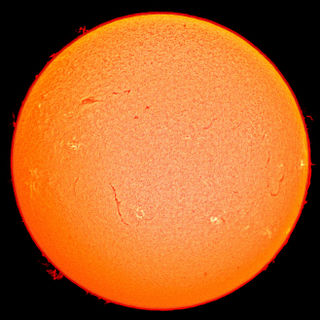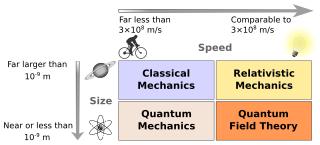It has been suggested that this article be merged with Scientific law . (Discuss) Proposed since May 2018. |
This article needs additional citations for verification .(February 2008) (Learn how and when to remove this template message) |
The laws of science, also called scientific laws or scientific principles, are statements that describe or predict a range of natural phenomena. [1] The term law has diverse usage in many cases (approximate, accurate, broad, or narrow theories) across all fields of natural science (physics, chemistry, biology, geology, astronomy, etc.). Scientific laws summarize and explain a large collection of facts determined by experiment, and are tested based on their ability to predict the results of future experiments. They are developed either from facts or through mathematics, and are strongly supported by empirical evidence. It is generally understood that they reflect causal relationships fundamental to reality, and are discovered rather than invented. [2]

The laws of science, also called scientific laws or scientific principles, are statements that describe or predict a range of natural phenomena. Each scientific law is a statement based on repeated experimental observations that describes some aspect of the Universe. The term law has diverse usage in many cases across all fields of natural science. Scientific laws summarize and explain a large collection of facts determined by experiment, and are tested based on their ability to predict the results of future experiments. They are developed either from facts or through mathematics, and are strongly supported by empirical evidence. It is generally understood that they reflect causal relationships fundamental to reality, and are discovered rather than invented.
A prediction, or forecast, is a statement about a future event. A prediction is often, but not always, based upon experience or knowledge. There is no universal agreement about the exact difference between the two terms; different authors and disciplines ascribe different connotations.
A scientific theory is an explanation of an aspect of the natural world that can be repeatedly tested and verified in accordance with the scientific method, using accepted protocols of observation, measurement, and evaluation of results. Where possible, theories are tested under controlled conditions in an experiment. In circumstances not amenable to experimental testing, theories are evaluated through principles of abductive reasoning. Established scientific theories have withstood rigorous scrutiny and embody scientific knowledge.
Contents
- Conservation laws
- Conservation and symmetry
- Continuity and transfer
- Laws of classical mechanics
- Principle of least action
- Laws of gravitation and relativity
- Modern laws
- Classical laws
- Thermodynamics
- Electromagnetism
- Photonics
- Laws of quantum mechanics
- Radiation laws
- Laws of chemistry
- Geophysical laws
- See also
- References
- External links
Laws reflect scientific knowledge that experiments have repeatedly verified (and never falsified). Their accuracy does not change when new theories are worked out, but rather the scope of application, since the equation (if any) representing the law does not change. As with other scientific knowledge, they do not have absolute certainty (as mathematical theorems or identities do), and it is always possible for a law to be overturned by future observations. A law can usually be formulated as one or several statements or equations, so that it can be used to predict the outcome of an experiment, given the circumstances of the processes taking place.

A statement, hypothesis, or theory has falsifiability if it is contradicted by a basic statement, which, in an eventual successful or failed falsification, must respectively correspond to a true or hypothetical observation. For example, the claim "all swans are white and have always been white" is falsifiable since it is contradicted by this basic statement: "In 1697, during the Dutch explorer Willem de Vlamingh expedition, there were black swans on the shore of the Swan River in Australia", which in this case is a true observation. The concept is also known by the terms refutable and refutability.

In mathematics an identity is an equality relation A = B, such that A and B contain some variables and A and B produce the same value as each other regardless of what values (usually numbers) are substituted for the variables. In other words, A = B is an identity if A and B define the same functions. This means that an identity is an equality between functions that are differently defined. For example, (a + b)2 = a2 + 2ab + b2 and cos2(x) + sin2(x) = 1 are identities. Identities are sometimes indicated by the triple bar symbol ≡ instead of =, the equals sign.
In mathematics, an equation is a statement that asserts the equality of two expressions. The word equation and its cognates in other languages may have subtly different meanings; for example, in French an équation is defined as containing one or more variables, while in English any equality is an equation.
Laws differ from hypotheses and postulates, which are proposed during the scientific process before and during validation by experiment and observation. Hypotheses and postulates are not laws since they have not been verified to the same degree and may not be sufficiently general, although they may lead to the formulation of laws. A law is a more solidified and formal statement, distilled from repeated experiment. Laws are narrower in scope than scientific theories, which may contain one or several laws. [3] Science distinguishes a law or theory from facts. [4] Calling a law a fact is ambiguous, an overstatement, or an equivocation. [5] Although the nature of a scientific law is a question in philosophy and although scientific laws describe nature mathematically, scientific laws are practical conclusions reached by the scientific method; they are intended to be neither laden with ontological commitments nor statements of logical absolutes.

The scientific method is an empirical method of acquiring knowledge that has characterized the development of science since at least the 17th century. It involves careful observation, applying rigorous skepticism about what is observed, given that cognitive assumptions can distort how one interprets the observation. It involves formulating hypotheses, via induction, based on such observations; experimental and measurement-based testing of deductions drawn from the hypotheses; and refinement of the hypotheses based on the experimental findings. These are principles of the scientific method, as distinguished from a definitive series of steps applicable to all scientific enterprises.
In logic, equivocation is an informal fallacy resulting from the use of a particular word/expression in multiple senses throughout an argument leading to a false conclusion. Abbott and Costello's "Who's on first?" routine is a well known example of equivocation.

Philosophy is the study of general and fundamental questions about existence, knowledge, values, reason, mind, and language. Such questions are often posed as problems to be studied or resolved. The term was probably coined by Pythagoras. Philosophical methods include questioning, critical discussion, rational argument, and systematic presentation. Classic philosophical questions include: Is it possible to know anything and to prove it? What is most real? Philosophers also pose more practical and concrete questions such as: Is there a best way to live? Is it better to be just or unjust? Do humans have free will?
According to the unity of science thesis, all scientific laws follow fundamentally from physics. Laws which occur in other sciences ultimately follow from physical laws. Often, from mathematically fundamental viewpoints, universal constants emerge from a scientific law.
The unity of science is a thesis in philosophy of science that says that all the sciences form a unified whole.
A physical law or a law of physics is a statement "inferred from particular facts, applicable to a defined group or class of phenomena, and expressible by the statement that a particular phenomenon always occurs if certain conditions be present." Physical laws are typically conclusions based on repeated scientific experiments and observations over many years and which have become accepted universally within the scientific community. The production of a summary description of our environment in the form of such laws is a fundamental aim of science. These terms are not used the same way by all authors.






























































